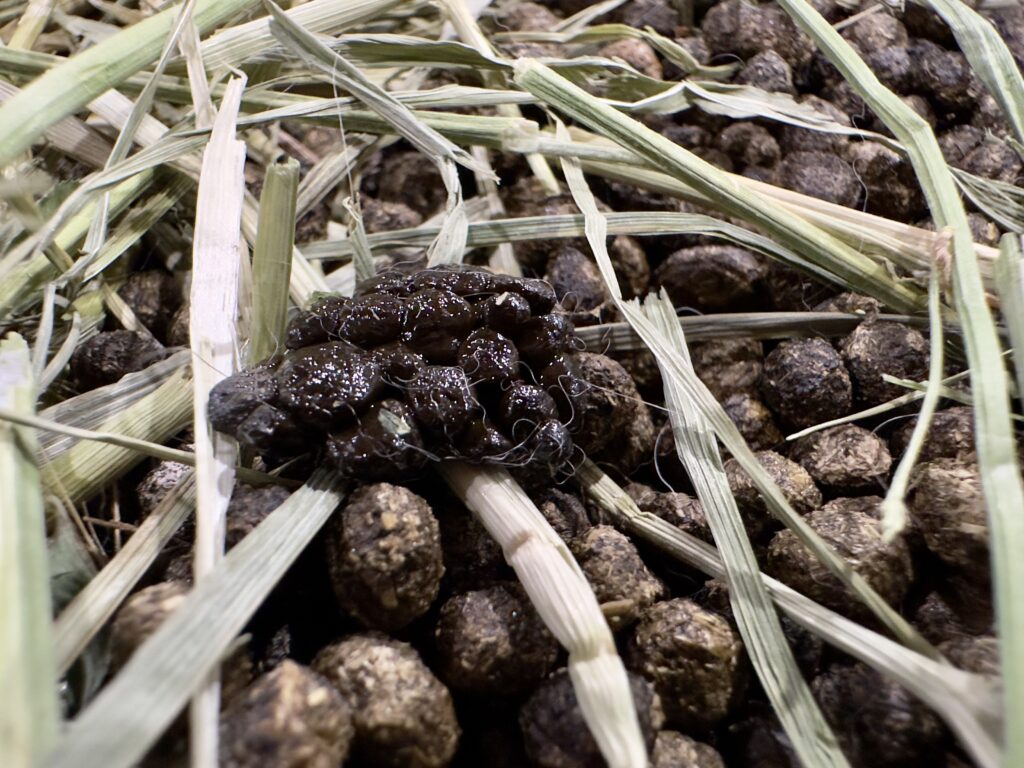Cecotropes are special droppings that rabbits consume directly from the anus before digestion.
To be more specific, “A caecotroph is the end stage of fermentation in the caecum that allows all of the digestible products in the diet to be absorbed by the rabbit” according to Dr Molly Varga, a qualified vet and RCVS Specialist in Zoo and Wildlife Medicine.1
Cecotrope droppings look like tiny bunches of grapes; they are blackish-greenish, coated in mucous, and carry a distinct “ripe” odor.
The importance of Cecotropes
Cecotropes play a vital role in the unique dietary strategy of rabbits, who boast a remarkable gastrointestinal (GI) tract designed for extracting nutrients from diverse sources. Both wild and domestic rabbits eat high-fiber foods: hay, grasses and leafy greens. All these foods must pass through the digestive tract twice for rabbits to obtain the maximum amount of nutrition. This dietary diversity sets rabbits apart, enabling them to extract essential nutrients from low-energy food materials that many other animals cannot effectively digest.
A key feature of their dietary adaptation is the production of cecotropes—special droppings that rabbits consume directly from the anus before digestion. Unlike regular waste materials, cecotropes are rich in organisms originating from the cecum, an area of the intestinal tract. These organisms are packed with valuable nutrients such as amino acids (proteins’ building blocks), fatty acids, and various vitamins. To harness these nutrients, rabbits must ingest and digest cecotropes, essentially allowing them to produce a key portion of their own nutritious food.
cecal nutrients2
Cecotrophs contain around 28-30% crude protein and up to 30% of the total nitrogen intake of rabbits. They are high in nitrogen, short-chain fatty acids, microbial protein, B vitamins, sodium, potassium, water, lysine, the sulfur amino acids, and threonine.3,4
The short-chain fatty acids in their cecals provide an additional source of energy, and the B vitamins provided can be in excess of the rabbit’s needs. It is estimated that B12 is synthesized 100x the daily requirement.4
Problems
In healthy rabbits, the consumption of cecotropes happens directly from the anus, and you won’t find these droppings in the litterbox or living area. However, if a rabbit faces medical issues preventing it from reaching the anus, cecotropes may be left about. A notable presence of undigested cecotropes may indicate a nutritional deficiency.
However, with many house rabbits – it’s the opposite. The presence of lots of uneaten cecotropes is often a sign your bunny has an eaten a lot of calorie-dense foods and not enough hay. An abundance of commercial pellets and high-calorie treats often result in a plethora of uneaten cecotropes. 80% of a rabbit’s diet should be hay.
If a bunny is consuming lots of pellets and treats and not much hay, a matted poopy butt often results.
NOtes
- Supreme Pet Foods (2023). The Ultimate Guide to Caecotrophs. Retrieved on 2023 Dec 20 from https://supremepetfoods.us/blog/the-ultimate-guide-to-caecotrophs/ ↩︎
- WabbitWiki (2023). Cecotropes. Retrieved 2023 Dec 20 from https://wabbitwiki.com/wiki/Cecotropes ↩︎
- Moore, L. (2013). Rabbit Nutrition and Nutritional Healing. (2nd ed.). ↩︎
- Quesenberry, K & Carpenter, J. (2012). Ferrets, Rabbits, and Rodents: Clinical Medicine and Surgery. (3rd ed.). ↩︎
- Quesenberry, K & Carpenter, J. (2012). Ferrets, Rabbits, and Rodents: Clinical Medicine and Surgery. (3rd ed.). ↩︎

